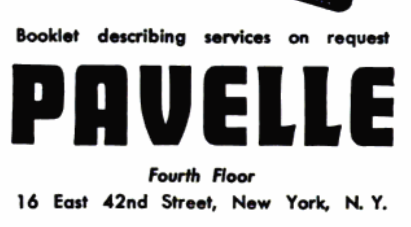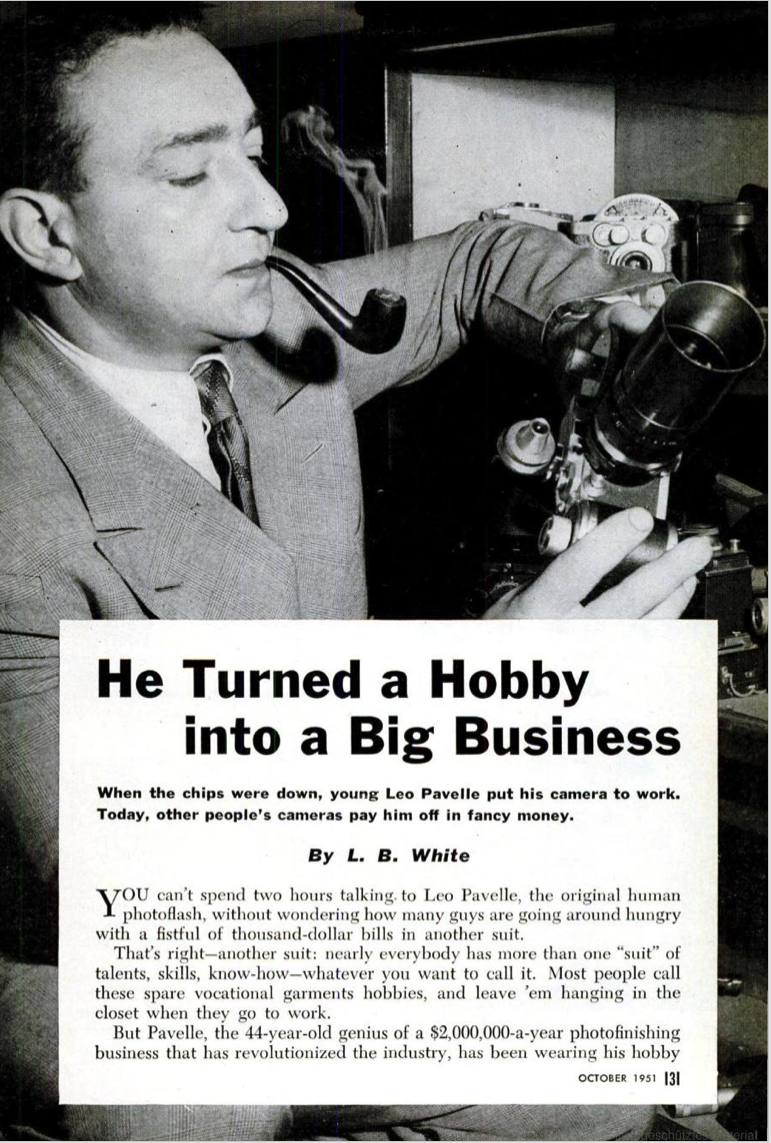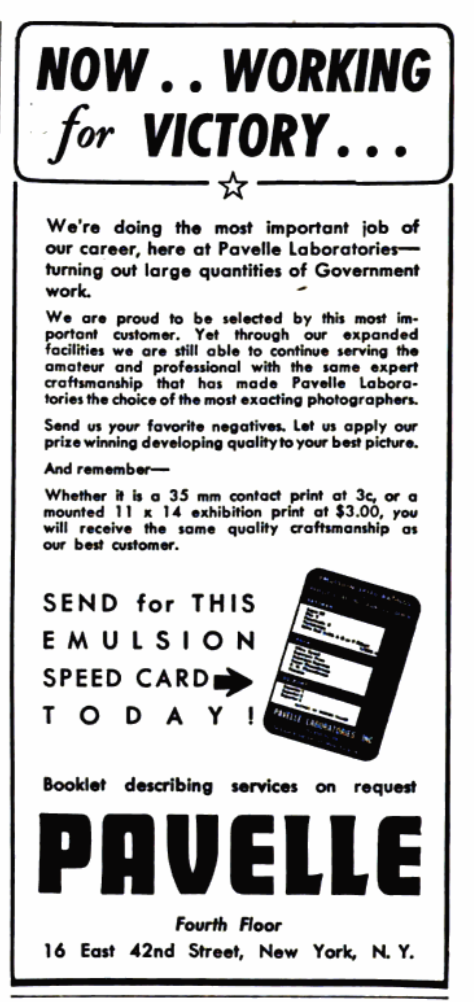Archive
Pavelle Laboratories Inc.
- Pavelle Laboratories Inc.
- Photo LabPhoto Supplier
Pavelle Laboratories was found in 1936 by Leo and Carmen Pavelle and operated on East 42nd Street. It was specialised in the development of miniature camera film and one of the first labs working with colour film.
Word Count: 36
16 East 42nd Street, Midtown Manhattan, New York City (1936–1960s); 553 West 57th Street, Hell's Kitchen, New York City (1938–1960s).

Logo of Pavelle Laboratories in Popular Photography, December 1943, p. 88. 
Article on Pavelle Laboratories (White 1951, 131). 
Article on Pavelle Laboratories in White 1951, 132–133). 
Advertisement for Pavelle Laboratories in Popular Photography, December 1943, p. 88. Anonymous. "West Caldwell Will Get New Pavelle Plant."The Herald News, 6 March 1969, p. 26
Berkowitz, George. “Typed memo to Marion Palfi.” (unpublished material, Center for Creative Photography, The University of Arizona, Tucson, 20 April 1949).
Coote, Jack H. The Illustrated History of Colour Photography. Fountain Press, 1993.
Enyeart, Jim. “Marion Palfi – Social Research Photographer.” Exposure. Journal of the Society for Photographic Education, vol. 11, no. 3, August 1973, pp. 4–6. Accessed 19 February 2021.
Gilbert, George. The Illustrated Worldwide Who’s Who of Jews in Photography. G. Gilbert, 1996.
Marion Palfi, special issue of The Archive - Research Series, no. 19, September 1983. Center for Creative Photography, University of Arizona.Accessed 19 February 2021.
Rockwell, Peter L.M. and Peter W. Knaack. Out of the Darkroom: A Short History of the Photofinishing Industry. 2 P Press, 2006.
U.S. Camera, vol. 18, no. 1–6, 1955.
Word Count: 140
- 1936
- 1970
Leo Pavelle, Carmen Pavelle, Seymour Pavelle, Marion Palfi.
- New York
- Helene Roth. "Pavelle Laboratories Inc.." METROMOD Archive, 2021, https://archive.metromod.net/viewer.p/69/2948/object/5145-11016582, last modified: 20-08-2021.
-
Marion PalfiPhotographerNew York
Marion Palfi was a German émigré photographer who lived in New York from the 1940s to the 1960s. Her photographic engagement in social and political topics made her name for her use of the camera to draw attention to social injustices.
Word Count: 41
Black Star AgencyPhoto AgencyNew YorkThe German émigrés Kurt S(z)afranski, Ern(e)st Mayer and Kurt Kornfeld founded Black Star in 1936. The photo agency established was a well-run networking institution in New York.
Word Count: 31
Oceana PublicationsPublishing HouseNew YorkOceana Publications Inc was a publishing house specialising in law and civil rights founded by the British émigré Philip F. Cohen (1911–1998) in 1945.
Word Count: 22
Rapho GuillumettePhoto AgencyNew YorkFounded in 1940 by the emigrant Charles Rado (1899–1970), Rapho Guillumette was a picture agency.
Word Count: 13
Three Lions Inc.Photo AgencyNew YorkLittle is known about this photo agency, which was founded by two German émigré brothers, Max Georg and Walter Löwenherz in 1937 in New York
Word Count: 25
Modernage Photographic Services IncPhoto LabNew YorkModernage Photographic Services was founded in 1944 by the German émigrés Ralph and Leuba Baum and specialised in photofinishing services. In 1954 a second branch, Modernage Custom Darkrooms, was opened.
Word Count: 29
Service Photo Suppliers Inc.Photo SupplierNew YorkService Photo Suppliers was a photo supplier distributing a wide variety of photo equipment and opened by the German émigré Hans Salomon (1909–?) in 1945.
Word Count: 23
SpiratonePhoto SupplierNew YorkSpiratone was a photo company and photo supplier founded in 1941 by the Austrian émigré family Hans (1888–1944) and Paula Spira (?–?) and their son Fred Spira (1924–2007).
Word Count: 24
PIX Publishing Inc.Photo AgencyNew YorkPIX Publishing Inc. was a photo agency founded in New York in 1935 by photo agent Leon Daniel and Celia Kutschuk, together with German émigré photographers Alfred Eisenstaedt and George Karger.
Word Count: 30
Leco Photo ServicePhoto LabNew YorkLeco Photo Service was a photofinishing lab, highly-frequented and a contact hub for émigré photographers and photo agencies during the 1930s and 1940s, as well as a provider of employment for women in the photo industry.
Word Count: 36
Camera FeaturesPhoto AgencyNew YorkCamera Features was a photo agency founded by the photographer Werner Wolff and other colleagues of the photo agency PIX.
Word Count: 20
European Picture ServicePhoto AgencyNew YorkThe European Picture Service was a photo agency located in Midtown Manhattan founded, probably in 1930, by the émigré photographer Max Peter Haas (1901–1985).
Word Count: 22
JJK Copy-ArtPhoto LabPhoto StudioPhoto SupplierNew YorkJJK Copy-Art was a photo studio and photofinishing service founded in 1929 by the Jewish Austrian émigré James J. Kriegsmann (1909–1994) and was located at 165 West 46th Street.
Word Count: 26
Lotte JacobiPhotographerNew YorkIn October 1935 the German émigré photographer Lotte Jacobi, together with her sister Ruth Jacobi, opened a photo studio on 57th Street. The two sisters had to leave their parents' photo studio in Berlin in the 1930s and emigrated to New York.
Word Count: 41
Lilo HessPhotographerNew YorkThe German émigré Lilo Hess was an animal photographer working for the Museum for Natural History and the Bronx Zoo, as well being a freelance photographer and publisher of children's books.
Word Count: 31
YllaPhotographerNew YorkYlla was an Austrian-born photographer who emigrated to New York in 1941. Specialising in animal photography, she produced not only studio photographs, but also shot outside on urban locations in the metropolis.
Word Count: 31